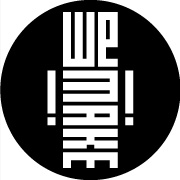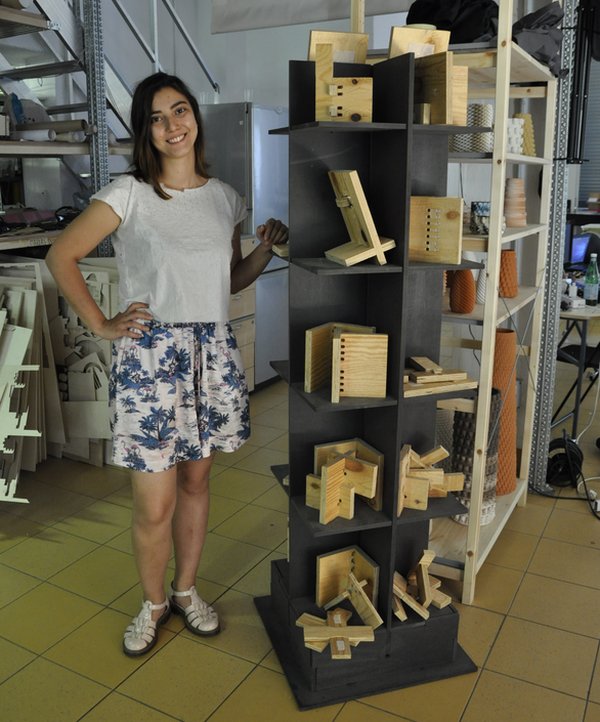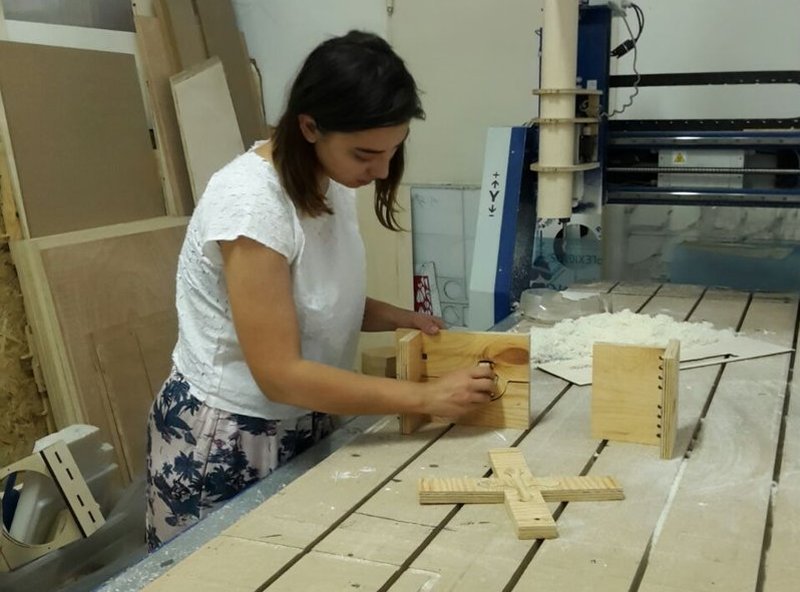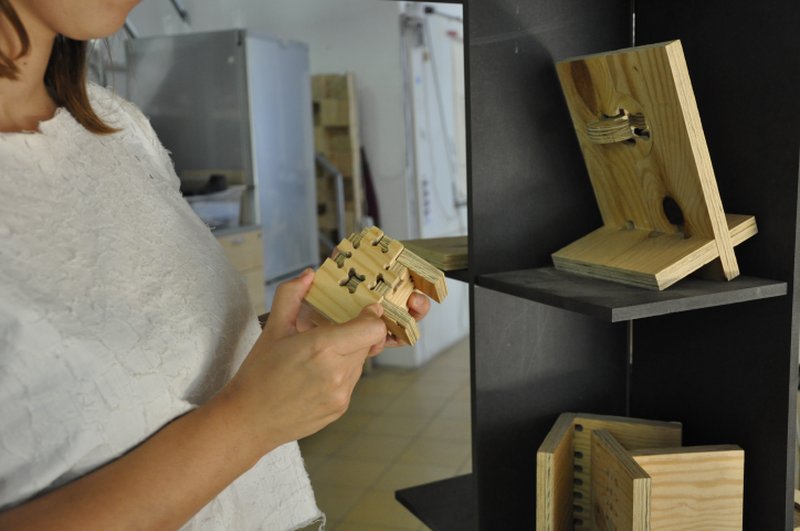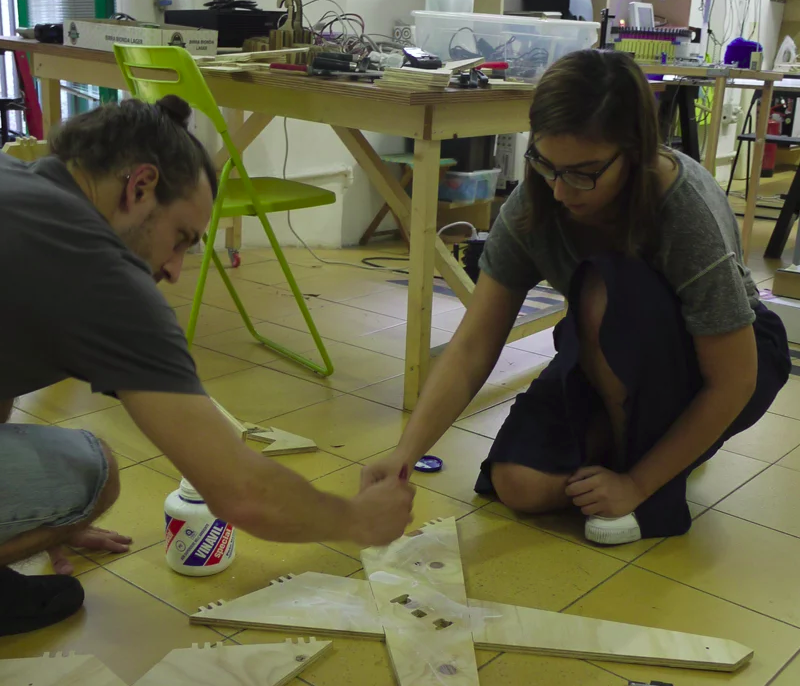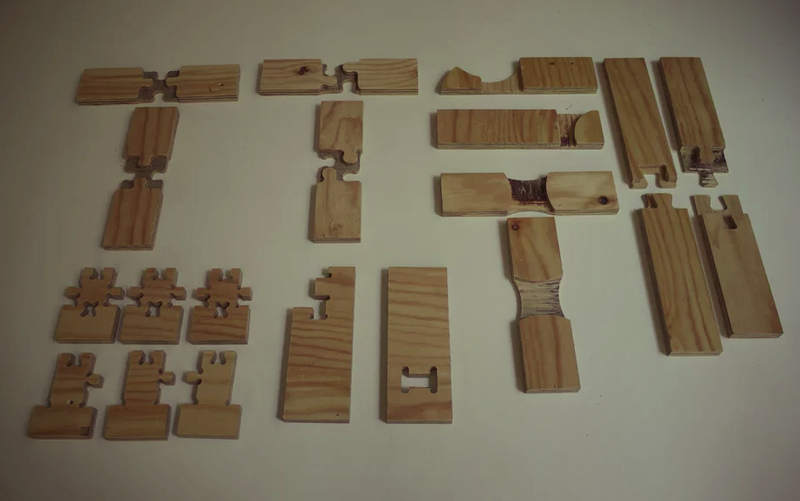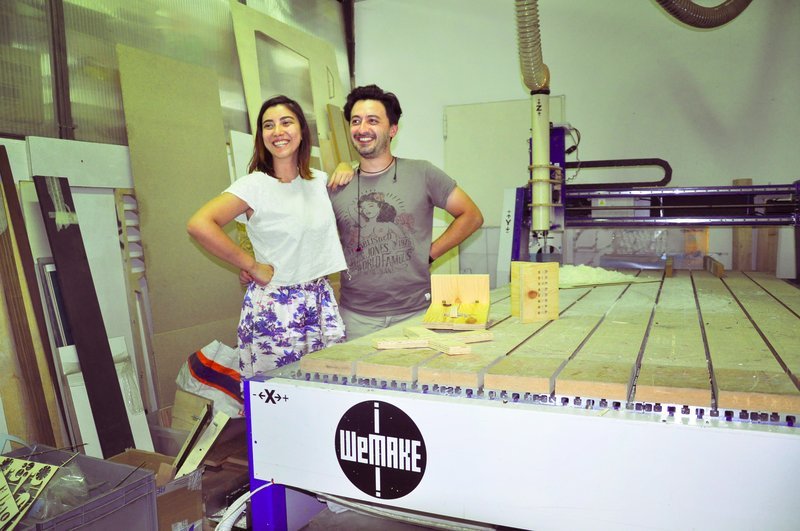#WeMakeStories: Ayse, what a maker can do with open source

Italian below
During June and July 2015 Ayse Esin Durmaz studying İnterior Design in Kadir Has University in Istanbul applied for a 2-month Erasmus+ Internship in our Makerspace. Her aim was to learn to design and produce furnitures with a CNC router. We proposed her to work on 50 digital joints project to make all the files available for WeMake CNC router.
After this experience she came back to Istanbul and now she is living in Germany and working in FabLab Kamp-Lintfort also thanks to the project she did here at WeMake. Ayse came to Milan last summer and we had the occasion to ask her what she is working on now, what are her plans for the future and what she thinks about the makers world.
What did you do after your summer in WeMake?
It was september 2015 and I went back to Turkey and continued my studies there, I was also looking for a job to improve my skills about furniture design and digital fabrication. I was studying interior design and I was looking for a job where I could keep together open source designs and furniture design since I knew how to do it. I was rejected by a lot of studios because they didn’t need that kind of skills.
It seems like the design world didn’t understand the maker world, isn’t it?
The studios I got in touch with couldn’t make the connection between the two worlds. I tried to tell them I knew how to actually make stuff. I did an interview in a studio where they were preparing installations for galleries and I told them I could help to make it easier with CNC and other tools. They were not interested but they suggested me to go to Atolye, it means “atelier” in turkish, it’s a makerspace, an event space and a coworking space: it’s an interdisciplinary creative area. There I started giving workshop about digital fabrication and I tried to make a connection between maker and designers, I tried to pass on the maker philosophy, how to integrate your designs, the feeling of power that making stuff without any help gives you. In a makerspace you design something, if it’s not satisfactory you can make a different prototype, test and customize it, and in the end, as it is open source, you can allow to do it anywhere else or start with mass production (here the interview about this experience).
How was the experience in this makerspace: were you satisfied as a maker?
It was a different era for me, I was coordinating the space and mainly producing workshop contents. I learned how to make business in a fablab, that is a different part of the life of a makerspace. Still I wanted to be a maker and produce digital designs this is why I’m now living in Germany.
Why did you go to Germany?
I applied there, sent my CV, and FabLab Kamp-Lintfort interested in what I did here at WeMake. Thanks to the open source projects “50 different joints”.
Why was your Internship at WeMake important for you?
It was a milestone! I wanted to become furniture designer: I came here, I made the joints, and I saw much more than furniture. I can do so many objects with 3dprint, molding technique and other machines, it also opened me to the study of different materials. I’ve learned how to use a machine to make something, how to customize a machine. Now when I have an idea I know that I can do it, that I can realize it! It’s the maker discipline, and I learned it here. At WeMake Costantino Bongiorno told me: you can make whatever you want, you are free! And it happened: I did my furniture design, I entered a interior furniture design competition and I won, it’s a big thing!
Tell me something you think is important for a maker.
I give you an example: as a maker I start designing a desk, then I make it, this means that I know all the process. And more: everybody now can produce my desk, because my work is open source. My desk is something physical, but it’s also digital so I can produce it anywhere. If you have my files, you can produce it again wherever you are.
What do you want to do in the future?
I want to remain a designer. I want to learn more about materials and how they behave, try new materials and new forms, I’m gonna look into it. I don’t care about what machine I use, I care for other methods to make something.
==============================
Nel periodo compreso tra giugno e luglio 2015 Ayse Esin Durmaz, studentessa di İnterior Design presso la Kadir Has University di Istanbul, ha partecipato a una Internship di 2 mesi presso il nostro Makerspace grazie al progetto Erasmus+. Il suo obiettivo era quello di imparare a progettare e produrre arredi con un router CNC. Le abbiamo proposto di lavorare sul progetto 50 digital joints e di rendere tutti i file del progetto fruibili con il router CNC di WeMake.
Dopo quell’esperienza è tornata ad Istanbul per proseguire gli studi e attualmente vive in Germania e lavora al Fablab Kamp-Lintfort anche grazie a quanto ha realizzato insieme a noi. Ayse è tornata a Milano quest’estate e abbiamo avuto occasione di chiederle su cosa sta lavorando, quali siano i suoi progetti per il futuro e cosa ne pensa della scena Maker.
Cosa hai fatto quell’estate dopo aver lasciato WeMake?
Nel settembre 2015 sono tornata in Turchia e ho proseguito gli studi. Contemporaneamente ho cercato un lavoro che mi permettesse di migliorare le mie skill nella progettazione di arredi e nella digital fabrication: studiavo Interior design e sapevo produrre progetti open source per arredi e oggetti, volevo continuare a sperimentarmi in quel contesto! Molti studi non hanno preso in considerazione la mia candidatura perché erano skill che non interessavano.
Sembra che il mondo del design e del making non si comprendessero molto l’un l’altro…
Gli studi di architettura e di design di interni non vedevano il collegamento tra i due mondi. Cercavo di spiegare in ogni modo come io sapessi produrre oggetti e non solo progettarli, ma niente da fare. A un certo punto durante l’ennesima intervista in uno studio che stava preparando le installazioni per una galleria, ho detto che avrei potuto produrre tutto il materiale con una CNC e altri strumenti. Non erano interessati, ma mi hanno suggerito di andare in un posto chiamato Atolye, che significa atelier in turco, in pratica un posto che è un makerspace, uno spazio per eventi e un coworking tutto insieme con un’ampia area creativa interdisciplinare. Ho iniziato a tenere dei workshop di digital fabrication ad Atolye mettendo in contatto il mondo dei maker e quello dei designer, cercando di far venire fuori la filosofia maker e soprattutto come poterla integrare nei progetti di design. Volevo comunicare la sensazione di realizzazione che ti trasmette il produrre i tuoi prototipi senza alcuna intermediazione. In un makerspace progetti qualcosa, se non ti soddisfa puoi fare un altro prototipo, lo puoi testare e customizzare e, alla fine, dato che è open source, puoi permettere a chiunque di rifarlo oppure iniziare una produzione di massa (qui l’intervista ad Ayse su questa esperienza).
Com’è stata la tua esperienza in questo makerspace? Sei soddisfatta come maker?
Stavo vivendo una fase diversa della mia esperienza professionale, coordinavo lo spazio e pensavo ai programmi dei workshop. Ho imparato come fare business in un fablab, un aspetto diverso di un makerspace rispetto a quello che ho vissuto qui a WeMake. Allo stesso tempo io volevo fare la maker e volevo fare digital design e questi sono i motivi per cui mi sono spostata in Germania.
Perché sei andata in Germania?
Banalmente ho mandato il mio curriculum e il Fablab Kamp-Lintfort si è interessato al lavoro sui joints che ho svolto qui a WeMake. Grazie al progetto open source “50 different joints” sono partita per la Germania!
Perché è stata importante la tua esperienza a WeMake?
È stata fondamentale! Volevo diventare una progettista di arredi d’interni: sono arrivata qui e ho cominciato a progettare giunti, e mi sono accorta che nel mondo c’erano cose molto più interessanti che i soli arredi. La stampante 3d, la CNC, le tecniche di modellazione mi hanno aperto il mondo dello studio di differenti materiali. Ho imparato come usare una macchina per costruire qualcosa, ho imparato come customizzare una macchina. Adesso, quando ho un’idea, so che la posso realizzare! È la “disciplina del maker” e l’ha imparata qui. A WeMake Costa (Costantino Bongiorno, ndr) mi ha detto: puoi fare tutto quello che vuoi, sei libera! Ed è successo: ho fatto furniture design progettando i miei mobili, ho partecipato a un concorso su questa materia e ho vinto, è una grande cosa!
Dimmi ciò che ritieni sia importante per un/a maker.
Ti faccio un esempio: come maker io progetto una scrivania e la realizzo, questo vuol dire che conosco tutto il processo. In più come progetto open source chiunque può realizzarlo, è un file digitale. È un prodotto reale, ma è digitale e per questo posso realizzarlo ovunque. Se hai i miei file, puoi riprodurre il mio oggetto dovunque tu sia.
Cosa vuoi fare nel futuro?
Voglio continuare a fare la designer. Voglio imparare più cose sui materiali e sulle loro proprietà, testarne di nuovi e fare ricerca in questo ambito. Non mi importa quali macchine usare, quello che mi interessa sono le metodologie con cui progettare e realizzare le cose, come si fanno!
